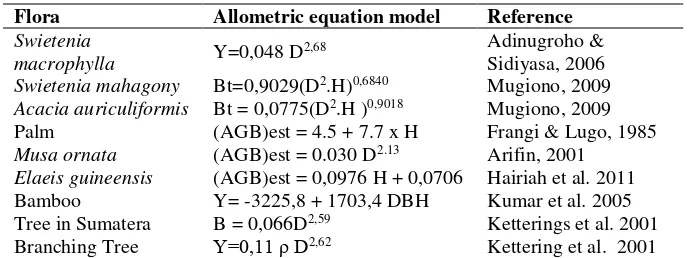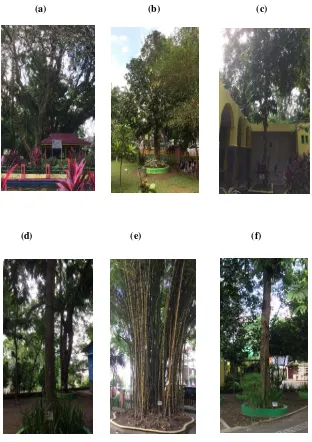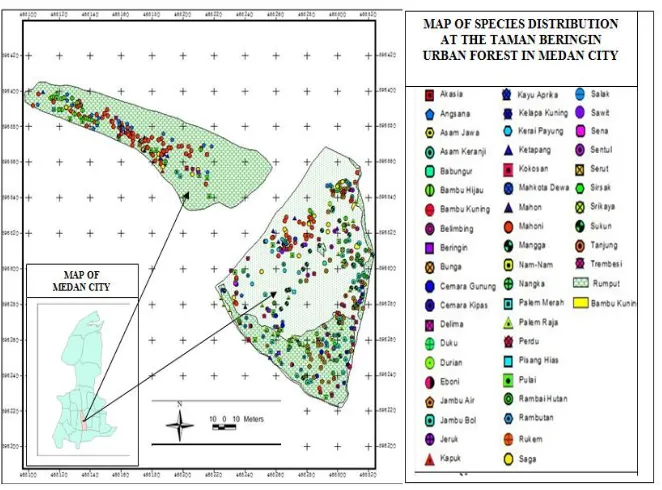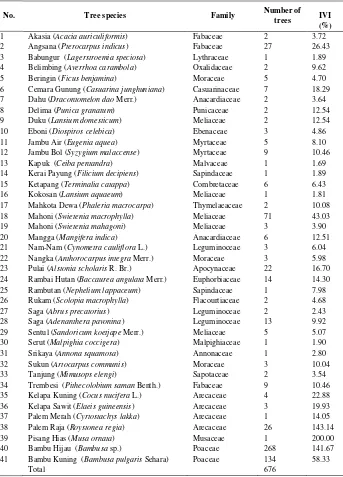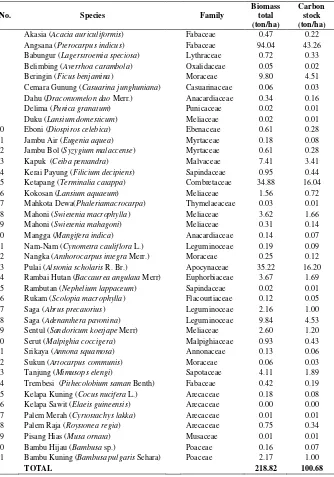73
DISTRIBUTION, ABOVE-GROUND BIOMASS
AND CARBON STOCK OF THE VEGETATION IN
TAMAN BERINGIN URBAN FOREST, MEDAN
CITY, NORTH SUMATRA, INDONESIA
RAHMAWATY
1*, NOVITA ARIANI SITORUS
1AND ABDUL RAUF
21Forestry Study Program, Faculty of Forestry, University of Sumatera Utara, Jl. Tri Dharma Ujung No. 1 Kampus USU, Medan 20155, Indonesia
2Agroecotechnology Study Program, Faculty of Agriculture, University of Sumatera Utara, Jl. A. Sofyan No. 3 Kampus USU, Medan 20155, Indonesia
*Corresponding author:
Email: rahma2107usu@gmail.com
Abstract: One type of green open space located in Medan City is the Taman Beringin Urban Forest. This study aimed to map the distribution of vegetation and to calculate carbon stocks of vegetation and above-ground biomass (AGB) at the Taman Beringin Urban Forest. A tree inventory was conducted using a census method to determine the types and number of tree species and to measure the diameter and height of the trees. A non-destructive sampling method was conducted to estimate the biomass, using an allometric formula. The calculation of biomass and carbon stocks or carbon was conducted for above ground level—that is, only for living vegetation. The types of flora in the urban forest include trees (34 species), ornamental plants (five species) and bamboo (two species). Overall, 676 trees were found. The total biomass was 218.82 ton/ha and the carbon stock was 100.68 ton/ha.
Key words: AGB, allometric model, carbon stock, Urban Forest
INTRODUCTION
74
Green open space is an absorber of carbon (carbon sink) and are effective in reducing carbon emissions in the atmosphere (Shannigrahi et al. 2003; Basri 2009). According to Dahlan (2011), one of the efforts to reduce emissions and air pollution in urban areas is the presence of green open space. Based on data provided by the Environment Agency of North Sumatra Province (2015), the amount of green open space in Medan City is not currently sufficient. Green open space in Medan City encompasses 2,120.8 ha or 8% of the total area of Medan City (26.510 ha).
The provision of green open space is regulated by the Law on Spatial Planning No. 26 (2007). Further, the provision of the supply and use of green open space is contained in the Regulation of the Minister of Public Works No. 5 (2008), a guideline for the provision and use of green open space in urban area, and the Regional Regulation of Medan City (Perda Kota Medan) No. 13 (2011). Under the regulation, the proportion of green open space in the urban area should be at least 30% and composed of 20% of public green open space and 10% of private green open space. This policy on the minimum proportions of green open space is intended to support the balancing of urban ecological systems and to ensure the requisite availability of clean air for the community; it can also provide aesthetic value to the spatial structure of the city.
Taman Beringin Urban Forest is a green open space located in the centre of Medan City (Jalan Sudirman). As it is clean, airy, easily accessible and does not require an entrance fee, the park is frequented by the public. The existence of urban forests is very important for creating a comfortable urban terrain, especially in terms of the absorption of carbon dioxide (CO2) and the provision of oxygen (O2): the green belt of Medan City serves as a CO2 sink. Given the lack of information regarding the distribution, the above-ground biomass (AGB) and the carbon stock of the vegetation at Taman Beringin Urban Forest in Medan City, North Sumatra, Indonesia, a study is essential for providing information about the current state of the forest and planning future development. This study aimed to map the distribution of vegetation in Taman Beringin Urban Forest and to calculate its carbon stocks and its AGB. It is anticipated that this research will provide information that can be used to determine management plans for the environmental development of Medan City.
MATERIALS AND METHODS
75
The primary data taken from Taman Beringin Urban Forest included the types, numbers, diameters and heights of the vegetation. Secondary data used as supportive data in this study comprised an administrative map of Medan and several existing allometric models (Table 1). The diameters of trees were measured to ascertain the growth-rate of vegetation (Manuri et al. 2016; Manuri et al. 2014; Krisnawati et al. 2012). Measurements were obtained at a fixed diameter breast height
(DBH) or at 1.3 m from the ground’s surface (Hairiah et al. 2011; Krisnawati et al. 2012; Manuri et al. 2014). The parameters used for estimating the biomass of bamboo, palms and bananas were height and diameter—or DBH—according to the allometric formula used (Table 1). All trees were measured in the standing position. The calculation of the value of biomass and carbon stocks or carbon stored is achieved using allometric models.
Table 1. The allometric formula used in this study
Flora Allometric equation model Reference
Swietenia
macrophylla Y=0,048 D
2,68 Adinugroho &
Sidiyasa, 2006 Swietenia mahagony Bt=0,9029(D2.H)0,6840 Mugiono, 2009 Acacia auriculiformis Bt = 0,0775(D2.H )0,9018 Mugiono, 2009
Palm (AGB)est = 4.5 + 7.7 x H Frangi & Lugo, 1985
Musa ornata (AGB)est = 0.030 D2.13 Arifin, 2001
Elaeis guineensis (AGB)est = 0,0976 H + 0,0706 Hairiah et al. 2011
Bamboo Y= -3225,8 + 1703,4 DBH Kumar et al. 2005
Tree in Sumatera B = 0,066D2,59 Ketterings et al. 2001
Branching Tree Y=0,11 ρ D2,62 Kettering et al. 2001
Note: Y = tree biomass (kg/ind); Bt = total biomass (kg/ind); (AGB) est = above ground biomass (kg/ind); B = total biomass (kg/ind); H = total height of vegetation (m); D = diameter at breast height (cm) at 1.3 m; ρ = wood density (gr/cm3).
The composition of tree species was determined by the important value index (IVI). The IVI consisted of the sum of the relative frequency, the relative density and the relative dominance (Mawazin & Subiakto 2013). The mastery level of each species in the community was indicated by the IVI (Kusmana 2017). The diversity of species was also calculated using the Shannon-Wiener diversity index (Kent & Paddy 1992).
RESULTS AND DISCUSSION
Taman Beringin Urban Forest is planted with various types of vegetation (Figure 1). The types of flora in the urban forest include trees (34 species), ornamental plants (five species) and bamboo (two species). Overall, 676 species were found. Swietenia macrophylla was the dominant tree found in the Taman Beringin Urban Forest (there were 71 individual trees), followed by Pterocarpus indicus (comprising 27 individual trees; see Table 2). The Poaceae family was the most prevalent, followed by the Meliaceae and Fabaceae families.
76
(d) (e) (f)
Figure 1. Vegetation at the Taman Beringin Urban Forest: a. Ficus benjamina, b. Syzygium malaccense, c. Baccaurea angulata Merr.,
d. Sandoricum koetjape Merr., e. Bambusa pulgaris Sehara, f. Alstonia scholaris R. Br.
77
Vegetation which is grown in Taman Beringin Urban Forest is aesthetic. Seedlings were planted in Taman Beringin by the Landscape Gardening Services Agency of Medan City as an effort to improve the quality and quantity of Taman Beringin urban forest. Plants have a very important role in absorbing CO2 emissions from transportation activities on the motorway (Berutu 2014). The CO2 emissions can be categorized into two, namely direct emissions (such as CO2 emissions from motor vehicles) and indirect emissions (such as electrical energy consumption in households) (Pradiptiyas 2011; Berutu 2014).
The distribution of the vegetation in Taman Beringin Urban Forest can be presented on maps using GIS technology. Among their other functions, maps show the spatial distribution of geographic phenomena, including their different positions on the surface of the earth. Maps can help to expand the limits of the human eye, allowing it to see the spatial characteristics of the environment. Based on its form, the urban forest can be classified into three types:
a. Clustered or accumulated (vegetation concentrated in an area of least 100 trees with dense and irregular spacing).
b. Spread (no particular pattern; vegetation growing in small, scattered clumps or clusters).
c. Tracked (vegetation growing in straight or curved lines, following the formation of rivers, roads, beaches and channels).
The distribution of plant species in the Taman Beringin Urban Forest is presented in Figure 2. As can be seen in Figure 2, the Taman Beringin Urban Forest is
categorised as ‘spread’.
78
79
The total amount of biomass in the Taman Beringin Urban Forest was 218.81 ton/ha and 100.65 ton/ha of carbon stock was found (Table 3).
80
There were 27 individual Pterocarpus indicus plants in the forest with an average diameter of 31.89 cm and an average height of 5.98 m. Pterocarpus indicus produced the greatest number of biomass and carbon stocks at 94.04 ton/ha and 43.26 ton/ha respectively. Alstonia scholaris R. Br.—of the family of Apocynaceae— produced the second-greatest values of biomass and carbon stocks at 35.22 ton/ha and 16.20 ton/ha respectively. Factors affecting the value of biomass include richness, vegetation type and diameter, the amount of vegetation, the vegetation density and the area size, in accordance with the work of Manuri et al. (2016), Manuri et al. (2014) and Krisnawati et al. (2012).
Tables 2 and 3 further indicate that the Bambusa sp. and Bambusa pulgaris Sehara had the highest number of individual plants but that their biomass and carbon stocks were low as a consequence of their small diameters (2.2 cm and 8.94 cm). Diameter and density of vegetation affect the value of biomass and carbon stocks (Manuri et al. 2014). Moreover, the potential for carbon stock is influenced by the composition of the diameter and the density of the trees, rather than the density of land cover. Forest types with high-density compositions are likely to produce more carbon stocks than forests of high density comprising tree species of lower weights (Maulana 2009).
Carbon stock was obtained by multiplying the value of the biomass to achieve the concentration of carbon in organic matter, which is equal to 46% (Hairiah & Rahayu 2007). The concentration of carbon stock was affected by many different parameters, for example: the diversity of vegetation types, the diameter and the density of individual plants. Where the diameter of the tree was large, the number of surrounding vegetation types was greater and, where the standing density was increased, the value of the biomass and carbon stocks was also significant (Adinugroho 2011). If the diameter of the tree was large, the number of types of vegetation was high, and the standing density was large, then the value of the biomass and carbon stocks was also great. For example: the diversity of vegetation types, diameter, and density of individuals. Planting tree species that has a diameter and a large canopy cover, such as Alstonia scholaris, Pterocarpus indicus, Swietenia macrophylla, Mimusops elengi, and Filicium decipiens can increase the level of absorption and carbon savings. According to Dahlan (2011), Switenia macrophylla also absorbs CO2 at a rapid rate (295.73 kg CO2 /tree/yr).
The important role of Taman Beringin Urban Forest was removing CO2 from the surrounding environment. It has a good potential for carbon storage. The addition of vegetation, the selection of the appropriate species and growing fast species were necessary to achieve the objectives of the green open space in Medan City, namely: for sustainability, harmony, and balance of urban ecosystems that include elements of environmental, social and cultural.
81
agroforestry at Sei Bingai Subdistrict, Langkat, North Sumatra were 58.438 ton/ha; in Bahorok Subdistrict, Langkat, North Sumatra, they were 63.005 ton/ha; and in Wampu Subdistrict, Langkat, North Sumatra, they were 56.76 ton /ha (Malau 2013; Rauf 2004). Hence, the carbon stocks in the Taman Beringin Urban Forest are capable of absorbing CO2 from and of providing O2 to Medan City.
CONCLUSION
The Taman Beringin Urban Forest is categorized as ‘spread’. The types of flora in the forest include trees, ornamental plants and bamboo. Overall, 676 species were found. The value of the diversity index for the study sites was 2.72. The total amount of biomass was 218.81 ton/ha and 100.65 ton/ha of carbon stock was found. The Bambusa sp. and Bambusa pulgaris Sehara had the highest number of individual plants but that their biomass and carbon stocks were low.
ACKNOWLEDGEMENTS
We are grateful to the University of Sumatera Utara, the organizing committee for the International Conference on Sustainable Forest Development in View of Climate Change (SFDCC) 2016 and APAFRI for supporting the presentation of this work on 8-11August 2016, at the Bangi Putrajaya Hotel, Malaysia. We also thank the students of the Faculty of Forestry at the University of Sumatera Utara who assisted with the field work.
REFERENCES
Adinugroho, W.C. 2011. Contribute to agroforestry systems to carbon reserves in the upstream of Bekasi Watershed. Thesis. Bogor Agricultural University. Bogor.
Arifin, J. 2001. Estimation of carbon storage on different forms of land use in Ngantang, Malang. Thesis. Brawijaya University. Malang.
Basri, I.S. 2009. The green belt for air pollution control in relation to quality of life in urban areas. SMARTek Journal 7(2): 113-120.
Berutu, G. 2014. Importance of vegetation role in the green open space to reduce CO2 emissions from transport activity results in highway (a case study of toll road: Bogor Ring Road, Section I). Accessed on 2016 August 1 from http://gibranius51e.blogstudent.mb.ipb.ac.id/2014/11/19/
Dahlan, E.N. 2011. The adequacy of urban forests as sinks of CO2 gas to anticipate the decrease of green open space areas in Bogor City. Forum Geografi 25(2): 164-177.
82
Frangi, J.L. & Lugo, A.E. 1985. Ecosystem dynamics of a subtropical flood plain forest. Ecological Monographs 55:351-369.
Hairiah & Rahayu, S. 2007. Measurement of Carbon Stock in Various Land Use. World Agroforestry Centre, ICRAF SEA Regional Office. Brawijaya University. Malang.
Hairiah., Ekadinata, A., Sari, R. & Rahayu, S. 2011. Measurement of carbon stock of land level to landscape. World Agroforestry Centre, ICRAF SEA Regional Office. Brawijaya University. Malang.
Irwan, Z.D. 1994. The role of city shape and city structure to environmental quality. Dissertation. Bogor Agricultural University. Bogor. 73pp.
Kent, M. & Paddy, C. 1992. Vegetation description and analysis: A practical approach. Belhaven Press, London. 428 pp.
Ketterings, Q.M., Coe, R., Noordwijk, M.V., Ambagau, Y. & Palm, C.A. 2001. Reducing uncertainty in the use of allometric biomass equations for predicting above ground tree biomass in mixed secondary forests. Forest Ecology and Management 146: 199-209.
Krisnawati, H., Adinugroho, W.C. & Imanuddin, R. 2012. Monographs: allometric models to predict trees biomass in different types of forest ecosystem in Indonesia. Research and Development Center for Conservation and Rehabilitation, Forest Research and Development Agency (FORDA). Bogor.
Kumar, B.M., Rajesh, G. & Sudheesh, K.G. 2005. Above ground biomass production and nutrient uptake of thorny bamboo [Bambusa bambos (L.) Voss in the home gardens of Thrissur, Kerala. Tropical Agriculture 43 (1-2) : 51-56.
Kusmana, C. 2017. Survey methods and vegetation data interpretation. Bogor: IPB Press. 68 pp.
Malau, Y. D. P., Rahmawaty. & Riswan. 2013. Carbon stock estimation of above ground biomass (AGB) in agroforestry land in Langkat. Peronema Forestry Journal (2) 2: 106-110.
Manuri, S., Brack, C., Nugroho, N.P., Hergoualc’h, K., Novita, N., Dotzauer, H.,
Verchot, L., Putra, C.A.S. & Widyasari, E. 2014. Tree biomass equations for tropical peat swamp forest ecosystems in Indonesia. Forest Ecology and Management 334: 241-253.
83
Masripatin, N., Ginoga, K., Pari, G. & Dharmawan, W.S. 2010. Carbon reserves in various forest and plant type in Indonesia. Research and Development Center on Climate Change and Policy. Bogor: FORDA.
Maulana, S.I. 2009. Carbon density estimation in primary forest in Jayapura, Papua. Forestry Economic and Social Research (7) 4: 261-274.
Mawazin & Subiakto, A. 2013. Species diversity and composition of logged over peat swamp forest in Riau. Indonesian Forest Rehabilitation Journal 1(1): 59-73.
Ministry of Law and Human Rights of the Republic of Indonesia. 2007. The Law of the Republic of Indonesia No. 26 (2007) on spatial planning. Jakarta: Ministry of Law and Human Rights of the Republic of Indonesia. 95 pp.
Ministry of Public Works. 2008. Guidelines for green open space provision and utilisation in urban areas. No. 05 / PRT / M / 2008. Jakarta: The Directorate General of Spatial Planning, Ministry of Public Works. 84 pp.
Ministry of Forestry. 2009. Regulation of the Minister of Forestry of the Republic of Indonesia No. 71 (2009). The implementation guidelines of urban forest. Jakarta.
Mugiono, I. S. 2009. Allometric from various type of tree for estimating biomass and carbon content in community forest. BPKH Wilayah XI Jawa-Madura and Forest Governance and Multi stakeholder Forestry Programme (MFP II). Yogyakarta.
Pradiptiyas, D. 2011. Analysis of green open space adequacy as an absorbing CO2 emission in urban using stella program (case study: in North Surabaya and East Surabaya). Thesis. Environmental Engineering Institute of Teknologi Sepuluh Nopember Surabaya. Surabaya.
Rauf, A. 2004. Assessment of system and optimization agroforestry land use in Gunung Leuser National Park buffer zone. Dissertation. Bogor Agricultural Institute, Bogor.
Rawat, J.S. & Banerjee, S.P. 1996. Urban forestry for improvement of environment. Energy Environment Monitor 12(2): 109-116.
Regional Development Planning Board of Medan City. 2011. Medan City spatial management planning related to regional land uses (2011–2031) No. 13 (2011). Regional Development Planning Board of Medan City, Medan. 41 pp.
84
Sukoco, M. 1990. Regional planning cartography. Forum Geography. Indonesian Journal of spatial and Regional Analysis 4 (2):1990.
The Government of the Republic of Indonesia. 2002. The Indonesian Government’s (2002) Regulation No. 63 about urban forests. Jakarta.
